

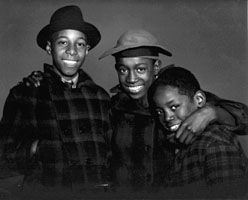 1.
1940: This was the first photograph I made with my new Speedgraphic. It's
a synchro-sunlight exposure--I used a flash to fill in the shadows and
overpower the sun which gives a dark sky in the background. That takes
a lot of calculating, and I lucked out and got it right. At first I printed
the negative trying to keep the dark skin light and burn in the teeth for
detail. Then one day, after putting the paper in the developer, the phone
rang and I didn't get back to it for two or three minutes; the print was
quite dark, but much more effective and I've been printing it that way
ever since. MSA SC 1890-41-10,025
1.
1940: This was the first photograph I made with my new Speedgraphic. It's
a synchro-sunlight exposure--I used a flash to fill in the shadows and
overpower the sun which gives a dark sky in the background. That takes
a lot of calculating, and I lucked out and got it right. At first I printed
the negative trying to keep the dark skin light and burn in the teeth for
detail. Then one day, after putting the paper in the developer, the phone
rang and I didn't get back to it for two or three minutes; the print was
quite dark, but much more effective and I've been printing it that way
ever since. MSA SC 1890-41-10,025
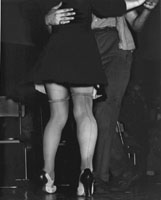 2.
c. 1941: This picture was taken one Saturday afternoon at a jam session
in a St. Louis tavern. This particular couple caught my eye because they
seemed to summarize the jitterbug character of the day. I pre-focused the
camera on one spot on the dance floor and set the camera vertically on
the floor. When they danced to my spot, I snapped the shutter, not even
looking through the viewfinder. In 1945, when Edward Steichen reviewed
my portfolio, he paused at this photograph and said, "Young man, if you
keep making photographs like this one, you'll be a good photographer some
day." MSA SC 1890-41-10,019
2.
c. 1941: This picture was taken one Saturday afternoon at a jam session
in a St. Louis tavern. This particular couple caught my eye because they
seemed to summarize the jitterbug character of the day. I pre-focused the
camera on one spot on the dance floor and set the camera vertically on
the floor. When they danced to my spot, I snapped the shutter, not even
looking through the viewfinder. In 1945, when Edward Steichen reviewed
my portfolio, he paused at this photograph and said, "Young man, if you
keep making photographs like this one, you'll be a good photographer some
day." MSA SC 1890-41-10,019
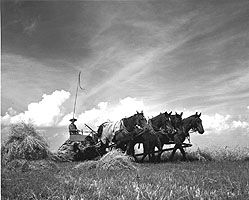 3.
1942: About a month before I went into the Navy, my friend Wally Simmons
and I went over to East St. Louis to see what we could find to make pictures
of. We were always looking for subjects for camera club competitions. We
found this scene: the clouds were so spectacular and with the horse-drawn
binder silhouetted against them it made a dramatic record of an era. I
knew I had a winner. MSA SC 1890-41-10,011
3.
1942: About a month before I went into the Navy, my friend Wally Simmons
and I went over to East St. Louis to see what we could find to make pictures
of. We were always looking for subjects for camera club competitions. We
found this scene: the clouds were so spectacular and with the horse-drawn
binder silhouetted against them it made a dramatic record of an era. I
knew I had a winner. MSA SC 1890-41-10,011
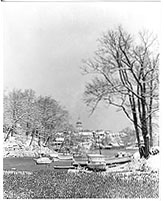 4.
1949: After we moved to Annapolis, I always went out on snowy days looking
for good views, and that's when I found this vantage point on Spa Creek.
I knew I needed to get up above the six-foot-high sea grass in the foreground,
so I piled up a bunch of wooden crates that had been dumped in this vacant
lot. Then I climbed up with my tripod and film holders and set up the camera
twelve feet above the ground. I used the rear element of a triple convertible
lens to make the picture; when I climbed down, I couldn't find the front
element. About a week later, when the snow melted, the neighbors called
me and said they'd found it, so I gave them a print of the picture. MSA
SC 1890-02-536A
4.
1949: After we moved to Annapolis, I always went out on snowy days looking
for good views, and that's when I found this vantage point on Spa Creek.
I knew I needed to get up above the six-foot-high sea grass in the foreground,
so I piled up a bunch of wooden crates that had been dumped in this vacant
lot. Then I climbed up with my tripod and film holders and set up the camera
twelve feet above the ground. I used the rear element of a triple convertible
lens to make the picture; when I climbed down, I couldn't find the front
element. About a week later, when the snow melted, the neighbors called
me and said they'd found it, so I gave them a print of the picture. MSA
SC 1890-02-536A
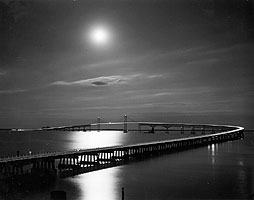 5.
July 1953: When the Bay Bridge opened in 1952, I immediately realized the
potential for a dramatic portrait at night. It took several tries to get
it right because I knew exactly where I wanted the moon and that placement
only occurs in summer. The picture was made from on top of the old Sandy
Point ferry terminal--about 60 feet above ground. There was so little traffic
then that I had to wait for a car onto come on the bridge, and I knew it
took four minutes to get across, so that's how I timed the exposure. To
prevent the streak of light from being too bright in the foreground, I
reached around the camera and slowly stopped the diaphragm down to F32
as the car rounded the curve. I'm still amazed that it worked. MSA SC 1890-02-20B
5.
July 1953: When the Bay Bridge opened in 1952, I immediately realized the
potential for a dramatic portrait at night. It took several tries to get
it right because I knew exactly where I wanted the moon and that placement
only occurs in summer. The picture was made from on top of the old Sandy
Point ferry terminal--about 60 feet above ground. There was so little traffic
then that I had to wait for a car onto come on the bridge, and I knew it
took four minutes to get across, so that's how I timed the exposure. To
prevent the streak of light from being too bright in the foreground, I
reached around the camera and slowly stopped the diaphragm down to F32
as the car rounded the curve. I'm still amazed that it worked. MSA SC 1890-02-20B
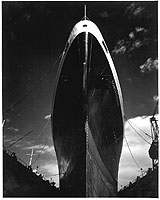 6.
1954: A friend offered to take me into the Key Highway yards of Bethlehem
Steel to see the Constitution while she was in dry dock. I was only
there for ten minutes--just long enough for this one shot. The next day
was the last day for entries for the National Press Photographers competition,
so I rushed home and made a 16x20 print and sent it off. I won a set of
Encyclopedia Britannica for the Picture of the Year in the pictorial
category. MSA SC 1890-03-1160B
6.
1954: A friend offered to take me into the Key Highway yards of Bethlehem
Steel to see the Constitution while she was in dry dock. I was only
there for ten minutes--just long enough for this one shot. The next day
was the last day for entries for the National Press Photographers competition,
so I rushed home and made a 16x20 print and sent it off. I won a set of
Encyclopedia Britannica for the Picture of the Year in the pictorial
category. MSA SC 1890-03-1160B
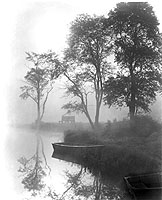 7.
1956 circa: I was doing so much work for the State that we had an arrangement
with the State Forester: when there was a cancellation for one of their
cabins, we would get free lodging in exchange for doing pictures of the
parks. This year we were at Herrington Manor in Garrett County. It was
a foggy summer morning, and I wandered off with my camera to see what I
could find. I saw this scene, got it set up, and waited about 20 minutes
in hope that someone would come along and sit down on the bench. No one
did, but I shot it anyway. MSA SC 1890-12-2283A
7.
1956 circa: I was doing so much work for the State that we had an arrangement
with the State Forester: when there was a cancellation for one of their
cabins, we would get free lodging in exchange for doing pictures of the
parks. This year we were at Herrington Manor in Garrett County. It was
a foggy summer morning, and I wandered off with my camera to see what I
could find. I saw this scene, got it set up, and waited about 20 minutes
in hope that someone would come along and sit down on the bench. No one
did, but I shot it anyway. MSA SC 1890-12-2283A
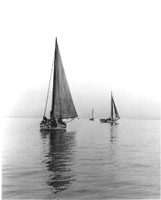 8.
1956: I was out on a Tidewater Fisheries patrol boat, covering the oyster
fleet all day, just taking advantage of a free ride. Photographing boats
is a wonderful opportunity to play with compositions because they move
almost in slow motion. You just watch them drift into various formations,
and wait for the right moment. Sometimes it never happens. MSA SC 1890-25-12,664-20
8.
1956: I was out on a Tidewater Fisheries patrol boat, covering the oyster
fleet all day, just taking advantage of a free ride. Photographing boats
is a wonderful opportunity to play with compositions because they move
almost in slow motion. You just watch them drift into various formations,
and wait for the right moment. Sometimes it never happens. MSA SC 1890-25-12,664-20
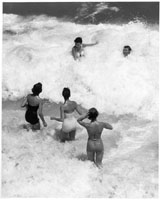 9.
1958: My arrangement with the State was that I would make pictures throughout
the year with no pay, then at the end of the fiscal year they would order
prints of what I had shot with whatever money was left in the budget. This
year they got us a free apartment in Ocean City. One day after lunch, I
talked these waitresses into putting on their swimsuits and coming out
to play in the surf. I like the way you can see the individual forms, yet
it's obviously unposed. And the one girl who's fending off the waves and
the other with the big smile--I couldn't have arranged it that well deliberately.
MSA SC 1890-24-16
9.
1958: My arrangement with the State was that I would make pictures throughout
the year with no pay, then at the end of the fiscal year they would order
prints of what I had shot with whatever money was left in the budget. This
year they got us a free apartment in Ocean City. One day after lunch, I
talked these waitresses into putting on their swimsuits and coming out
to play in the surf. I like the way you can see the individual forms, yet
it's obviously unposed. And the one girl who's fending off the waves and
the other with the big smile--I couldn't have arranged it that well deliberately.
MSA SC 1890-24-16
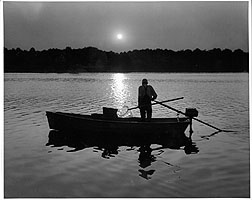 10.
1960 circa: With a 4x5 camera you only get one chance at a shot like this.
We'd been out on the Bay and were headed in at sunset when I saw this man
crabbing at the mouth of the Severn River. The sun was just hitting his
net, and the reflections were perfect. At the time I took the picture,
I thought he was fishing. Twenty years later I went out crabbing with my
son-in-law, who was using a technique I was unfamiliar with: running a
trot-line. When I learned the procedure--netting crabs along a string to
which bait is tied--I suddenly realized that was what this man had been
doing when I made this picture. MSA SC 1890-25-814
10.
1960 circa: With a 4x5 camera you only get one chance at a shot like this.
We'd been out on the Bay and were headed in at sunset when I saw this man
crabbing at the mouth of the Severn River. The sun was just hitting his
net, and the reflections were perfect. At the time I took the picture,
I thought he was fishing. Twenty years later I went out crabbing with my
son-in-law, who was using a technique I was unfamiliar with: running a
trot-line. When I learned the procedure--netting crabs along a string to
which bait is tied--I suddenly realized that was what this man had been
doing when I made this picture. MSA SC 1890-25-814
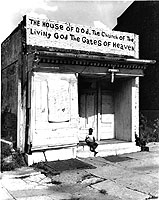 11.
July 1969: I found this building on Sharpe Street when I was documenting
the area for the Baltimore Urban Renewal and Housing Authority. I realized
that it would be a great photograph, but the sun wasn't quite right. I
was waiting for it to creep up to light the shadows when this little boy
came along and said, "Take my picture." I thought he made a perfect little
cherub. MSA SC 1890-03-2544-2
11.
July 1969: I found this building on Sharpe Street when I was documenting
the area for the Baltimore Urban Renewal and Housing Authority. I realized
that it would be a great photograph, but the sun wasn't quite right. I
was waiting for it to creep up to light the shadows when this little boy
came along and said, "Take my picture." I thought he made a perfect little
cherub. MSA SC 1890-03-2544-2
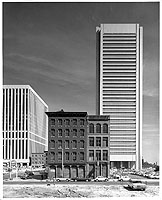 12.
1974 circa: This photograph exemplifies my belief that the simpler you
can make the image, the more dramatic its impact will be. I saw this scene
and was immediately struck by its potential. I saw it as an editorial statement
about the loss of beauty and human scale in our architecture, but I've
sold it several times to people who interpret it as a symbol of progress.
I guess beauty really does lie in the eye of the beholder. MSA SC 1890-03-2977A
12.
1974 circa: This photograph exemplifies my belief that the simpler you
can make the image, the more dramatic its impact will be. I saw this scene
and was immediately struck by its potential. I saw it as an editorial statement
about the loss of beauty and human scale in our architecture, but I've
sold it several times to people who interpret it as a symbol of progress.
I guess beauty really does lie in the eye of the beholder. MSA SC 1890-03-2977A
| The Eye of the Beholder | The War and Before |
| Sleepytime Annapolis | Annapolis in Blossom |
| The Chesapeake Bay | Vintage Photographs |
| Cityscape | About Maryland |
|
Tell Us What You Think About the Maryland State Archives Website!
|